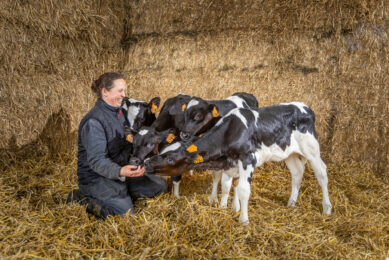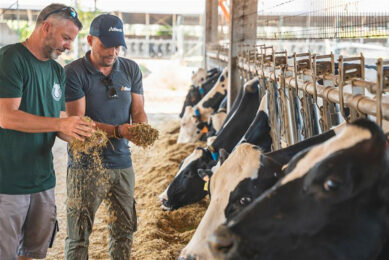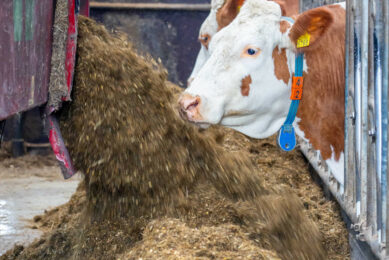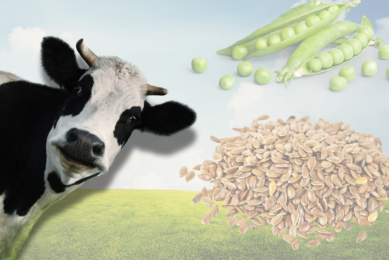Dairy lipids to narrow the gap between colostrum and calf milk replacer
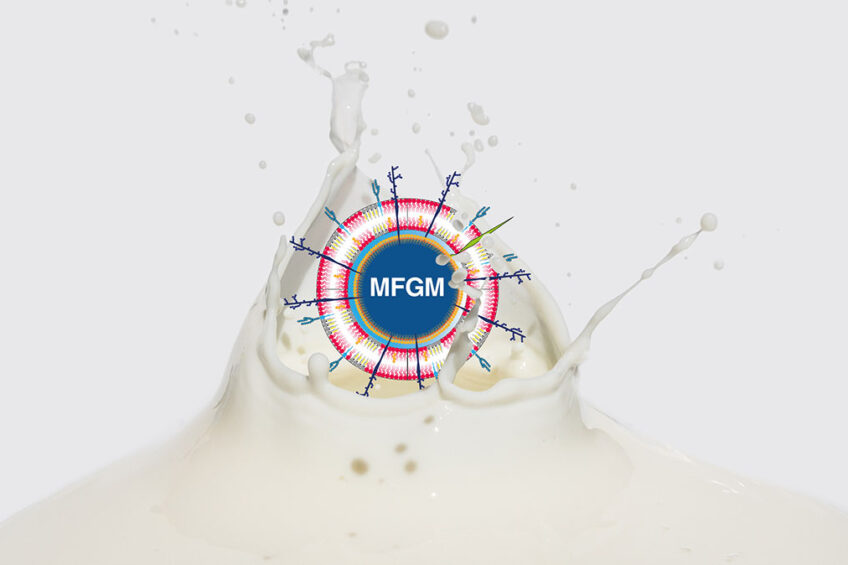
In the diet of young mammals such as calves, dietary fat provides energy, but it’s also essential for tissue growth, cardiovascular health and the development of the enteric nervous system and the immune system. Nukamel investigated the benefits of including Milk Fat Globule Membrane (MFGM) in milk replacers for young livestock.
Based on an extensive body of research on how a lipid-containing component of cow’s milk called MFGM benefits the development and health of newborn infants as well as rat and mice pups, Nukamel has investigated the benefits of its inclusion in milk replacers and other products for young livestock species, including calves, piglets and broiler chicks.
First, a little about the structure of MFGM. As its full name suggests, it’s a membrane that surrounds the lipid core of milk fat globules with 3 layers of various lipid types. It’s studded with proteins (over 500 types, mainly glycoproteins that resist digestion) and carbohydrates (mainly glycoproteins or glycolipids).
Benefits
Some of these specific MFGM components are bioactive, notes Nukamel R&D manager, Dr Evi Croes, but they also provide synergistic benefits in combinations and because of their structural organisation. “The lipid-lipid and lipid-protein interactions within the MFGM structure afford these molecules a degree of persistence in the gastrointestinal lumen,” she explains. “Because of this, they are conveyed to the large intestine where they play specific roles, such as strengthening the immune response, promoting intestinal development and providing direct antimicrobial effects.”
In infants, consumption of MFGM-enriched formula has been shown, for example, to reduce the number of days with fever and help prevent infections through actions such as prevention of pathogen adhesion to the gut epithelium.
“Similarly, studies on rodent and piglet models have shown benefits of MFGM on infection, inflammation, brain composition, and gut barrier integrity, as well as intestinal development,” says Croes. “In rat pups, MFGM-supplemented diets fed from day 5 resulted in a better restoration of the intestinal villus and crypt architecture and improved expression of tight junction proteins, which help prevent pathogen entry. Inflammatory response with a MFGM-rich diet was significantly lower, and serum levels of different cytokines – damaging immune system molecules – were reduced, leading to reduced stress on the gut barrier.”
In another study, MFGM-enriched formula fed to rat pups resulted in microbiome effects similar to littermates fed mother’s milk.
In young piglets, there were similar effects: accelerated maturation of the intestinal immune system that was closer to that observed in mother-fed piglets, increased mucosal growth and enhanced protection against the invasion of pathogens. There were also higher plasma IgG antibody levels and active colonisation of the gut with short-chain fatty acid-producing bacteria with dietary MFGM.
“Long-term effects were also seen in adult pigs that had received a dairy lipid-supplemented diet after birth,” says Croes. “Compared to the control diet animals, which were fed vegetable oils, there were lower pro-inflammatory cytokine secretions in response to a lipopolysaccharide challenge, confirming the beneficial impact of dairy lipids on the intestinal immune system.”
Young livestock
Although there were few initial studies, they caught the attention of Croes and her colleagues. “As we specialise in young livestock animal nutrition, we always keep up with infant nutrition research and research on dairy ingredients,” she explains. “We looked into where we could get MFGM raw materials. MFGM-enriched dairy ingredients can be produced commercially either from whey or from cream concentrates and they have only become readily available in the last 5 years or so as interest in using MFGM in infant formula has increased. We analysed the different raw materials and sought those treated only with low heat to maintain as much of the biological value as possible. In 2019 we carried out our first trials with broiler chicks and calves, testing various formulations and percentages of MFGM.”
Dairy calves
Nukamel considered the development of a specific milk to be provided to dairy calves (dairy or dairy-beef cross) after colostrum, to narrow the gap between colostrum and a calf milk replacer, says Croes, as a great opportunity to investigate the bioactive molecules in MFGM. It was expected that at this stage of the calf’s life, MFGM would provide positive benefits such as better gut development and stimulation of the immune system, as it had been shown to do in prior pig, rat and human infant research.
Nukamel held trials in 2020 in which calves given milk containing MFGM were compared to a control group. For the treated group there were benefits in terms of growth, health and starter feed intake. From there, Nukamel developed the ProtéGo concept for calves in the first 2 weeks of life. Calves need protection to survive and to build up immunity; then they are ready to grow.
In another Nukamel trial in 2021, a group of 25 calves received Nukamel ProtéGo (24.5% protein and 22% fat) for 2 weeks, while 2 other groups of 25 calves each received 1 of 2 competing products. Average daily gain (kg/day) was 0.27, 0.26 and 0.23, respectively, and gain to feed ratio (kg/kg) was 0.350, 0.318 and 0.284, respectively, within the first 2 weeks. Cases of diarrhoea were 2, 11 and 18 in the 3 groups, and divergent manure scores were 22, 26 and 30. Calves on the ProtéGo diet were also on average 2 kg heavier (after 8 weeks) compared to the average of the other 2 treatments.
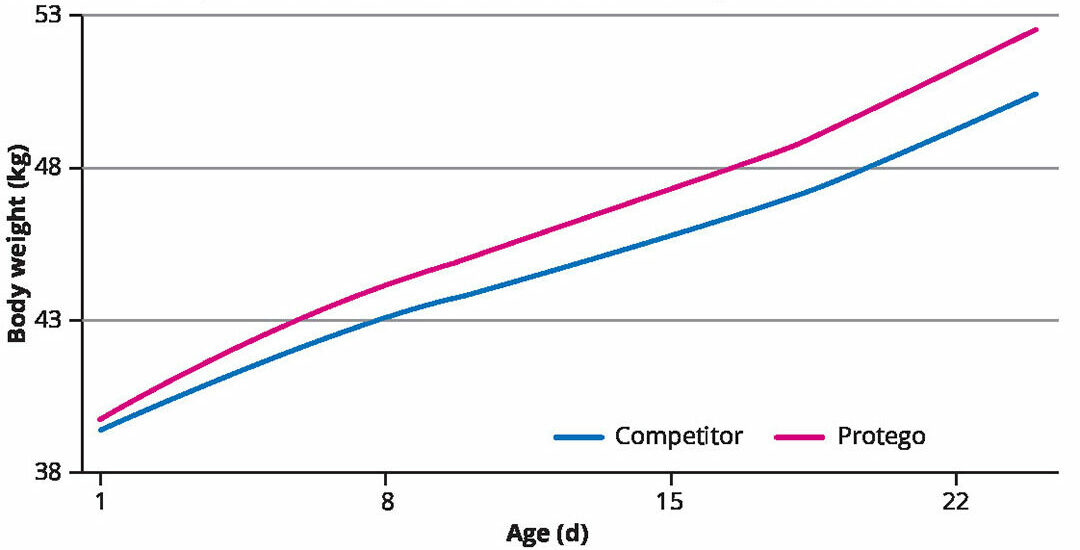
In the second trial, Nukamel ProtéGo was tested in a field trial with 25 individually-housed calves against a competitor start milk fed in the first 2 weeks of life. Calves on the ProtéGo treatment had a 2 kg heavier weight at day 17 compared to the calves on the competitor start milk (Figure 1).
Economic returns
In terms of ROI, Croes notes that this depends on the individual farm in terms of calf/colostrum management, dairy breed, labour costs and so on.
More specifically, if you choose to feed Nukamel ProtéGo instead of another milk replacer, on average the investment per calf is about € 15, says Croes, but € 13 less per calf is spent on antibiotics, veterinary costs and/or supplements to counteract diarrhoea and other issues. Later in life, she adds, because the calf has better growth and is better developed, there is less time to calving with savings of € 120/calf and increased milk production (~350 litres/cow), leading to additional earnings of about € 125/head (based on a historical average milk price of € 0.35/litre).
Croes adds that in terms of combatting antibiotics resistance, the ProtéGo concept also offers great potential. “The best thing we can do to reduce antibiotic use is to prevent disease from occurring in the first place,” she notes. “Scour is the most common cause of death in calves less than 1 month of age, while pneumonia is the most frequent cause of death of calves aged between 1 and 5 months. Investing in proper management and nutrition right from the start is critical to prevent this.”
Join 13,000+ subscribers
Subscribe to our newsletter to stay updated about all the need-to-know content in the dairy sector, two times a week.



